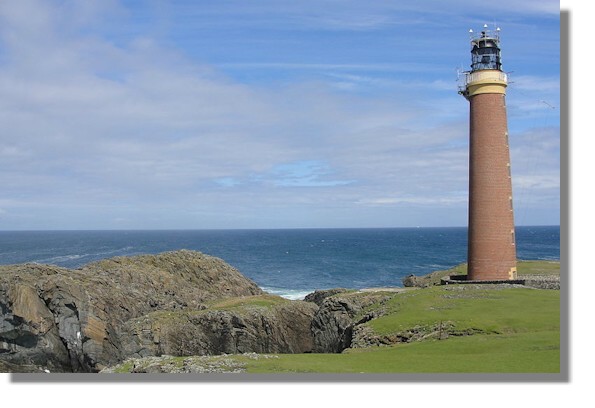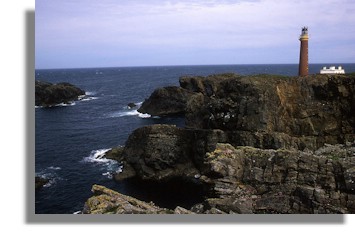

Lighthouse Beacons from Scotland
Butt of Lewis Lighthouse

Photo via Wikimedia
The Butt of Lewis (Scottish Gaelic: Rubha Robhanais) is the most northerly point of the Isle of Lewis in the Outer Hebrides. The Guinness Book of Records says that it is windiest location in the United Kingdom. The nearest populated area is the village of Eoropie, about 1-mile (1.6 km) to the south and it is about 19 miles from Stornoway, the main town on The Isle of Lewis. (The graphic on the right is by Sharma Krauskopf).
David Stevenson, who was at the time Engineer to the Northern Lighthouse Board, built the lighthouse in 1862. Little is known of the Station's early days, though the first light displayed was probably fixed rather than flashing, but this is not certain. Stevenson argued that it should be flashing to distinguish it from Cape Wrath which alternated between red and white and also from Stour Head which was going to be a fixed light also. However The Department of Trade apparently ruled that it was to be a fixed light. However, the original fixed light was altered and reinstalled so that a flashing white light showed every 20 seconds. This was achieved with a fixed light source housed inside a large lens, like a giant magnifying glass. The lens revolved round the light, which gave the flashing effect. The lens was driven by a clockwork motor which the light keeper had to wind by hand every 1/2 hour during the evenings. The Butt of Lewis was manned by three Keepers who lived at the Station with their families. The beacon reached 25 miles into the Atlantic. The Butt of Lewis was totally automated on 30 March 1998, one of the last to be converted. The nearby foghorn ceased operation in 1995. (The graphic on the left is by Tom Pullman via Wikimedia).
The tower is 37 metres high. Unlike many Scottish lighthouses, red bricks were used instead of Common Bricks. The Stevensons said that to use "common brick" at The Butt of Lewis would not be feasible as it would not withstand the exposure to the sea.
The present equipment was installed in 1905, when the characteristics of the light was one flash every twenty seconds. In 1869, paraffin is known to have replaced the vegetable or fish oil initially used. In 1976 the power source was changed to electricity. (The graphic on the right is by Tom Richardson via Wikimedia)The tower is now designated as a "listed" building of architectural importance.
The Lighthouse supplies were all delivered by sea since up until the 1960's the road structure in the Isle of Lewis was poor which meant that fuel and supplies could not be delivered by road.
The Butt lighthouse has taken on an important new role of monitoring and assisting in the establishment of four new lighthouses built by the Northern Lighthouse Board to guide ships to the new oil fields west of Lewis
Return to Index of Lighthouse Beacons from Scotland




